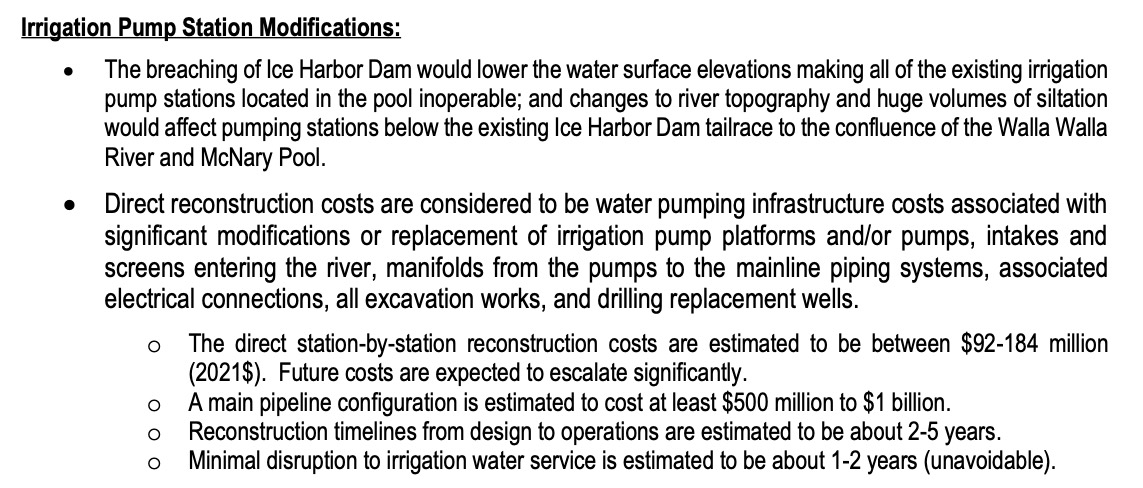forum
library
tutorial
contact

How Many Acres get Lower Snake River Water?
Irrigators, Corps Differ by 44,500 Acres
by Matthew Weaver
Capital Press, April 16, 2024
|
the film forum library tutorial contact |

|
How Many Acres get Lower Snake River Water?
by Matthew Weaver
|
"The 2020 EIS irrigation impact estimate is dead wrong," -- Darryll Olsen, Columbia-Snake River Irrigators Association
 The U.S. Army Corps of Engineers and a regional irrigators association differ by a wide margin in their estimates of how many irrigated acres would potentially be impacted by removal of the lower Snake River dams.
The U.S. Army Corps of Engineers and a regional irrigators association differ by a wide margin in their estimates of how many irrigated acres would potentially be impacted by removal of the lower Snake River dams.
The Corps says it's about 48,000 acres, citing its 2020 Columbia River Systems Operations environmental impact statement.
The irrigation analysis for the EIS was done by the U.S. Bureau of Reclamation as a co-lead agency, said Dylan Peters, public affairs specialist for the Corps Walla Walla, Wash., district.
A representative of the Columbia-Snake River Irrigators Association, however, says that acreage is far too low.
Darryll Olsen, board representative of the association, says the number of acres irrigated with lower Snake River water is 92,500.
"The 2020 EIS irrigation impact estimate is dead wrong," said Olsen.
The majority of the 92,500 acres that would be affected by dam breaching are CSRIA members, Olsen said.
The estimate was prepared by the Bureau of Reclamation's Denver Technical Center, Olsen said.
"They ignored the impacts below the Ice Harbor tailrace that include changing river topography and the very large silt deposits below Ice Harbor to the confluence of the Walla Walla River," he said.
"The (bureau) made multiple errors in their irrigation analysis -- very poorly done," Olsen said. "They concluded that all the Ice Harbor acreage would come out of production -- not true. They used county tax assessment values to calculate market values -- dead wrong."
CSRIA originally voiced its concerns about the EIS in a 2020 memorandum.
Asked last March about CSRIA's position regarding the 2020 EIS, Peters said none of the Corps' subject matter experts "were specifically involved with this particular topic," and declined to comment.
CSRIA has prepared a report for the Washington State Legislature and the state Department of Ecology's Office of the Columbia River. That report used "actual market transactions" to calculate distressed asset values, and determine mitigation requirements, Olsen said.
The bureau is now including CSRIA's irrigation impact acreage estimates under the Columbia Basin Restoration Initiative settlement agreement, Olsen said.
"We have not made any decisions regarding data," said Michael Coffey, public affairs specialist for Reclamation's Columbia-Pacific Northwest region. "We will provide our contractor, once identified, the available existing studies, including the CSRIA report, and expect them to validate information as they prepare the Reclamation study."
CSRIA was an intervener-defendant in the federal mediation led by the Biden administration between four Pacific Northwest tribes, the states of Oregon and Washington and federal agencies operating the dams. The irrigators association opposes dam breaching, but supports the agreement because it puts up to a 10-year stay on breaching, Olsen said.
Navigation 'deficiencies'
The 2020 EIS also had "severe technical deficiencies" in the navigation-transport sector, failing to include the basic rail route for alternative wheat transport from the river area, according to Olsen and CSRIA.
The association believes the state needs to request a proposal from railroad operators Watco, a supply chain logistics company, and the Union Pacific Railroad for an operational and financial review of the rail analysis.
Others in the agriculture industry felt ignored during the mediation process, but Olsen has argued that regional outcry against the agreement is "overstated."
“The agreement mediation directly supported the plaintiffs and defendants review, and defendant-interveners were allowed clear access to convey their positions in multiple meetings,” the association stated in December. “The mediators facilitated independent discussions between CSRIA and the plaintiffs, allowing for an understanding of what would be acceptable to reach some kind of (lower Snake River) agreement. Other parties could have had similar in-person consultations with the plaintiffs as well.”
"I have been a federal EIS contractor and participant in multiple Corps river studies for 30 years," Olsen said. "Competence and honesty are what makes for sound decision making. And one also has to retain the skill set to deal with these issues."
Related Pages:
Vilsack on Snake River Dams: Ag 'Well-Represented' in Mediation by Matthew Weaver, Capital Press, 8/1/23
learn more on topics covered in the film
see the video
read the script
learn the songs
discussion forum
